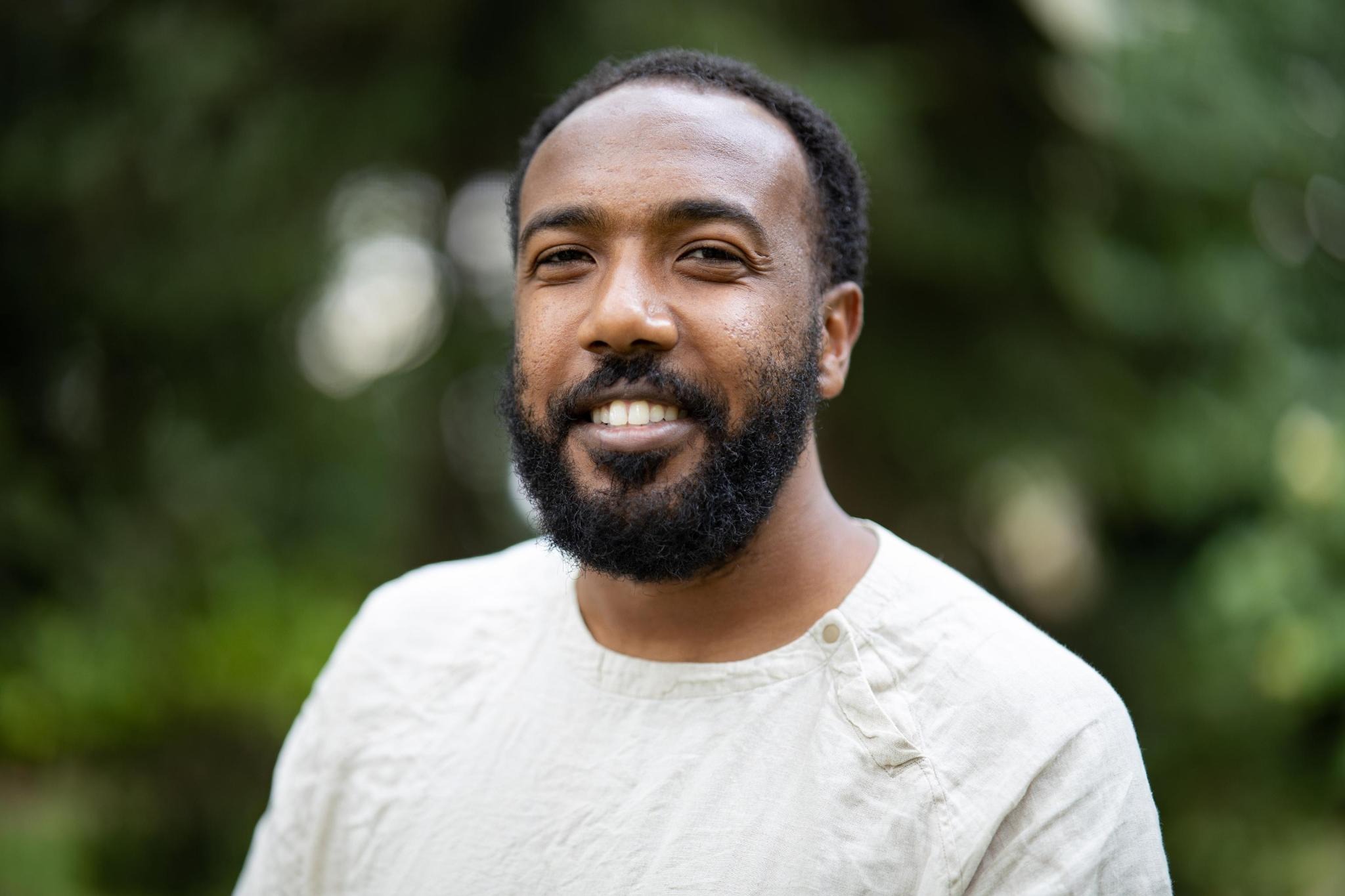The nonprofit helping immigrant communities navigate Trump’s America

Documented co-founder Mazin Sidahmed.
Independent news site Documented has emerged as a critical voice in the rapidly shifting landscape of immigration policy and coverage in the United States. Founded by Mazin Sidahmed and Max Siegelbaum in 2018, this outlet focuses on immigrant communities in New York for them to receive news that directly impacts their lives.
Sidahmed and Siegelbaum met while reporting in the Middle East. Both had similar professional backgrounds and frequently covered migration issues, Mazin based out of Beirut and Max in Cairo. By 2015, life and assignments had brought them both to New York City. There, they grew frustrated by the dominant media narrative on immigration, one that focused almost entirely on the US Southern border and on national politics, while neglecting the lived experiences of immigrants.
Mazin and Max decided to launch Documented to fill that gap, not just by reporting on immigrant communities but by directly serving them with helpful resources and critical news. According to its annual report, most of Documented’s revenue comes from philanthropic foundations with a small amount coming from advertising and individual donations.
Through innovative engagement strategies such as WhatsApp and WeChat channels tailored for Spanish- and Chinese-speaking audiences, as well as a Nextdoor account for the Caribbean immigrant community, the newsroom has built deep trust and provided vital, actionable information.
After Donald Trump’s inauguration, and as Immigration and Customs Enforcement (ICE) intensified enforcement actions against immigrants, Documented’s reporting has become more urgent than ever. Their team has been at the forefront of covering cases like the arrest of Columbia University graduate student Mahmoud Khalil, the suspension of Green Card applications for Refugees and Asylees and how people think about ICE arrests.
These aggressive enforcement measures have sent shockwaves through immigrant communities across New York and the entire country, creating a climate of fear even among those who have followed all legal procedures to establish their lives in the US.
Beyond news, Documented also offers essential resources for immigrants, including education and children’s services, employment and workers’ rights resources, health and safety information, food aid resources, and housing and shelter resources. Additionally, they also have the Wage Theft Monitor, the largest public repository of data on New York businesses found guilty of wage theft, helping workers hold employers accountable.
By combining investigative journalism with community-centered reporting, Documented has influenced policy discussions, exposed labor abuses, and addressed systemic issues affecting immigrant livelihoods. I recently spoke to co-founder Mazin Sidahmed to learn more about the project. He discussed the newsroom’s mission, the challenges of covering immigration, and the evolving role of journalism in an increasingly polarised world.
Q. What inspired you to launch Documented?
A. When Trump first came into office, we were seeing the ways in which immigration was being covered. There was this huge focus on what was happening in Washington DC, and on what was happening at the borders, but no one was covering what was happening locally. We thought that there was a real need for a new site that was covering immigration at the local level.
Critically, we wanted to make sure that we would cover this topic for immigrant communities. Both of us had these experiences of covering immigration in the Middle East, where you spend the whole day with someone in Lebanon on the border with Syria, listen to their stories, and then go back to the office and write a story in a language that this person couldn’t read. That relationship always felt very extractive to me. So we wanted to create a new site that was covering immigration issues but for the immigrant communities.
Q. What approach did you take to reach the communities you wanted to cover?
A. We listen first, that’s really the key to our approach. We learned a lot from the folks at Listening Post Collective (LPC) and other news outlets like Outlier Media that were building out these models whereby they set their editorial agenda by listening to the people that they want to serve.
So we went out to immigrant communities and we asked them: What kind of news do you want? What kind of news would be helpful to you? What do you think of the existing media landscape? We did something that LPC calls a ‘listening and information needs assessment’, and in order to do that, we just surveyed the people that we wanted to reach.
Q. How did you use audience feedback to shape your editorial approach and distribution strategy for different immigrant communities?
A. The first people we surveyed were undocumented Spanish speakers and they told us two main things.
Number one, when they are in the media, they are often portrayed as either victims or criminals. There’s no nuance to their kind of representation. Number two, they wanted actionable information about how to navigate New York City’s resources, and number three, people got most of their information from WhatsApp.
So we built this WhatsApp news service called Documented Seminal, where we have a kind of ongoing two way dialog with Spanish speakers in New York, and we distribute our news in Spanish via that platform as well. We repeated this for Chinese immigrants, and we built a WeChat account focused on serving Chinese immigrant communities. Then we did the same thing for Caribbean immigrants and built a Nextdoor account specifically focused on reaching the Caribbean immigrant community.
So that was our main focus, and we’ve worked on trying to meet people where they are and let them drive our editorial agenda.
Q. What strategies do you use to gain the trust of immigrant communities who may be wary of media organisations?
A. There’s a few factors when it comes to trust. The first one is that you have to close the loop. That’s the main way to build trust. A lot of people go out to do surveys, ask people questions, and then they disappear. So when we go out and do surveys,it’s really critical for us to come back to the community and say, ‘We heard what you said. Here’s what we’ve done in response to what you said.’
For instance, we said we would start delivering actionable information. So when somebody sends a question, we answer that question. We also make sure that we’re not writing checks that we can’t cash. So if we’re going to set up a service, we want to have it appropriately staffed so that people who use it and engage with it actually have good experiences.
The second thing that’s important is consistency. Really showing up regularly, not dropping off and being there on a consistent basis, so that when somebody has that moment of crisis, they know that you are there and that you can actually answer the question or get them the information they need.
Q. How do you measure the level of trust within the community?
A. We measure trust in the community through qualitative metrics, like people sending [our correspondent for Spanish-speaking communities] Rommel H. Ojeda personal messages like “Good morning, how are you?” and referring to him by his first name. Over the years, he’s become a trusted figure, not just a media representative. People even share sensitive information with him, and this shows how trusted he is.
Q. Can you share an example of a story or initiative that had a direct impact on policy or the community?
A. We measure impact on two levels: individual and systemic. On the individual level, we help people access resources like work permits, food and shelter through direct conversations. For example, last week, someone asked about getting a work permit, and we provided information on obtaining an EAD card.
The second layer focuses on systemic impact and policy changes based on what communities tell us they need. For example, a year or two after our founding, we engaged with immigrant communities to ask what information they wanted. This was during the first Trump presidency, when ICE raids dominated the news. Surprisingly, though, no one mentioned ICE raids. Instead, everyone brought up wage theft. Workers shared how their wages were being stolen and expressed a need for ways to recover them or fight back.
In response, we decided to create a database of all companies in New York State convicted of wage theft. The goal was to help workers identify employers with a history of wage theft, avoid them, and take action if needed. My co-founder, Max, filed a Freedom of Information lawsuit against the New York State Department of Labor to access this data. After four years, we succeeded and built a comprehensive database.
The impact has been significant. Lawyers and workers now use the database to check a company’s history when wage theft occurs, build campaigns, and hold employers accountable. It even influenced the New York State Legislature to introduce a series of bills aimed at strengthening consequences for repeat offenders.
Q. How do you see immigration coverage evolving in the coming years, especially as public sentiment and political attitudes toward immigration become more conservative?
A. Immigration coverage will continue to evolve. During the first Trump administration, many journalists entered the immigration beat for the first time, and we’re seeing that happen again now. As public sentiment around immigration in the US has become more hostile across the political spectrum, the media’s response will be something to watch.
The news media often mirrors public sentiment, so as the country shifts to the right on this issue, we’ll likely see changes in how immigration is discussed and covered. It’s going to be an interesting space to observe over the next few years.
Q. Are there any underreported stories or trends related to recent immigration policies that you feel the mainstream media is missing?
A. Initially there was a lack of reporting on how immigration is being used as a tool for propaganda. However, in recent weeks, I’ve seen some strong stories highlighting that this isn’t just about increasing arrests, it’s also about publicising those arrests and emphasising efforts on immigration issues. This shift in coverage is important, and the use of immigration as a propaganda tool is going to be a theme of this presidency moving forward.
Q. How do you navigate funding challenges?
A. Financial sustainability is a growing challenge for nonprofit newsrooms, especially at the local level. I am in the camp that believes there’s a strong case for philanthropic support for local news.
There has been a market failure in the local news sector, where it is incredibly difficult to sustain local news that’s civic minded and in the public interest. There isn’t a great kind of business model for that, especially if you’re serving rural communities. But there is a philanthropic case to be made for that, that it’s important for a healthy democracy. The press is an important institution to uphold and maintain in a city in the same way as a museum, university or a library. We might be heading for a world in which the sustainable model for news is always partially subsidised by some element of philanthropy. We need to become a bit more comfortable with that.
Q. What advice would you give to someone who wants to start reporting on immigration?
A. It’s a complicated but critical time to get into this beat. For a young person who wants to cover this beat I’d recommend learning a new language and spending significant time building trust with a specific community. Understanding immigration issues through the lens of one community you’ve developed a deep relationship with is a great way to start. For example, if you speak Spanish, French or Arabic, immerse yourself in a community that speaks that language and learn from their experiences.
Q. What advice would you give to a newsroom that wants to do better reporting on immigration?
A. For newsrooms, it’s about building cultural competency. Hire reporters from the communities you want to serve and ensure your team understands the complexities of immigration. This takes research, time and patience, but it’s crucial to approach this work with sensitivity and nuance. At Documented, we’re also developing tools to help newsrooms better serve immigrant communities, and we’ll be announcing those soon.
In every email we send you'll find original reporting, evidence-based insights, online seminars and readings curated from 100s of sources - all in 5 minutes.
- Twice a week
- More than 20,000 people receive it
- Unsubscribe any time
signup block
In every email we send you'll find original reporting, evidence-based insights, online seminars and readings curated from 100s of sources - all in 5 minutes.
- Twice a week
- More than 20,000 people receive it
- Unsubscribe any time







